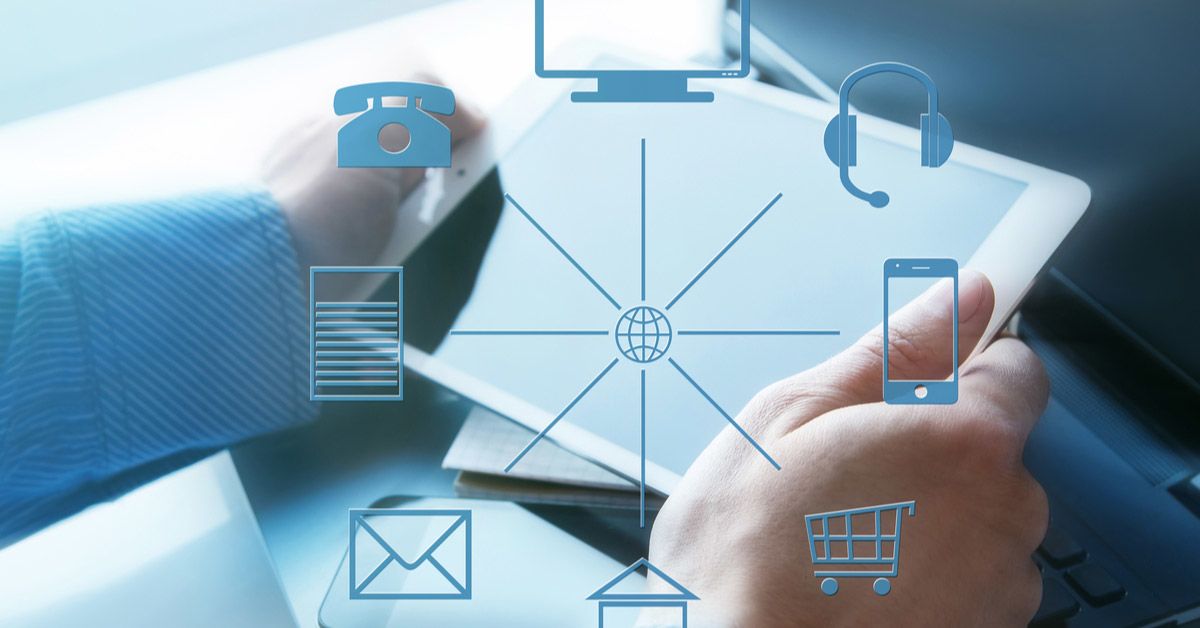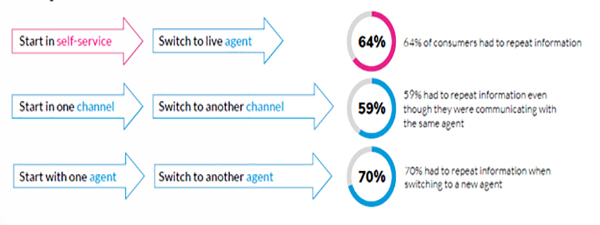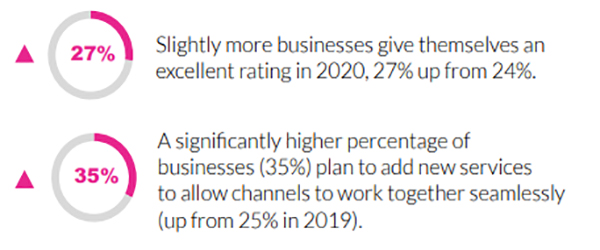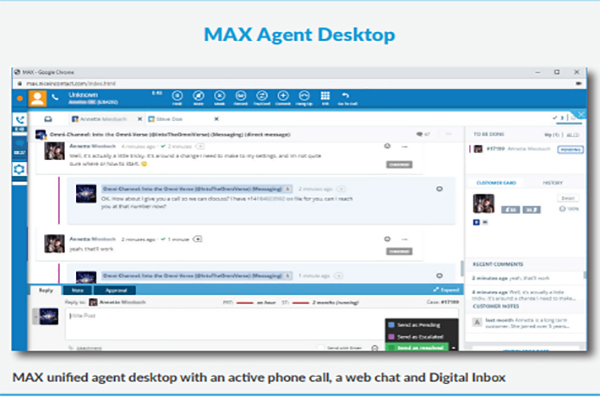Those of us in the customer service business have been talking about omnichannel customer experience for years, yet there is still much work to be done.
As an example, I recently emailed a business about an issue I was having with one of their products. I wrote a detailed description and even attached a photo that illustrated the problem. I was happy the company offered email support because it was the perfect communication method for my particular issue and my time and method by which I was able to communicate at that time, and I was confident that my problem would soon be resolved.
My confidence turned to frustration a few days later when I hadn't received a response to my email and called customer service to find out the status of my inquiry. The phone agent didn't know I had sent an email and also didn't have access to it. I had to re-explain my issue. That was frustrating enough, but without a visual aid, I wasn't sure the agent completely understood the problem.
I had to shake my head the next day when I finally received an email response that was quite different from what the phone agent told me.
This scenario probably sounds familiar. You may even think this doesn’t happen much anymore because we have been “solving” it for years. But, it does. Maybe you've experienced something similar or perhaps this could happen to your customers. It occurs when support channels aren't integrated, and agents don't have access to complete context. Ultimately, when businesses can't provide omnichannel customer experiences, it creates friction along the customer journey and results in frustrated customers (like me).
What is omnichannel customer experience?
When used to describe contact center interactions, an omnichannel customer experience enables consumers to move seamlessly across support channels as they design their own resolution journeys. This means, for example, that they can switch from an email channel to phone support without missing a beat.
Omnichannel is different from multichannel, although the two concepts are related. Most contact centers offer multichannel support. If an organization supports email and voice channels, they're multichannel but not necessarily omnichannel.
Revisiting my service example, the business I was dealing with was clearly multichannel but not omnichannel. If the phone agent was able to access the email I sent, that would have been an omnichannel experience. Similarly, if the email response I finally received said something along the lines of, "I see you called customer service yesterday and had your issue resolved. Please let us know if we can be of further assistance," that's an omnichannel customer experience.
Multichannel is a good first step towards becoming omnichannel. Today's consumers expect businesses to provide multiple ways to communicate with them. But they also expect companies to make it easy and convenient to move across channels.
What are the main characteristics of an omnichannel customer experience?
To further illustrate the concept of omnichannel customer experience, let's take a closer look at the primary characteristics.
Integrated support channels
Businesses that want to provide their customers with seamless experiences need to integrate their channels so that information flows freely across them. Even if an organization has the best chat, voice, and email applications in the industry, if they're not integrated it's impossible to truly optimize CX and the customer journey. This is why organizations are encouraged to look at the end-to-end journey rather than just focusing on making every touchpoint phenomenal. Even amazing touchpoints won't completely satisfy customers if they're disconnected.
Full context available to agents
When information flows smoothly across channels, this gives agents the context they need to efficiently resolve inquiries and not make customers repeat the details of their issues. Additionally, ready access to purchase history, past contact center interactions, and other pertinent customer data gives agents (and self-service solutions) the information they need to deliver more personalized and satisfying experiences.
Consistent experiences across channels
Contact centers that deliver superior omnichannel customer experiences not only integrate their channels but ensure the channels provide consistent experiences. Going back to my unfortunate service example, the email and voice channels had vastly different response times. Some delay is expected in asynchronous channels such as email, but the time lag was too long. Additionally, a fully optimized omnichannel contact center would ensure I received a consistent resolution to my issue in every channel I used.
Why contact centers need to provide omnichannel customer experiences
The ability to provide omnichannel customer experiences is becoming increasingly imperative. Here are some of the top reasons contact centers should make implementing omnichannel capabilities a priority.
1. Consumer expectations
Today's digital, connected consumers expect to interact with companies in their channel of choice using their preferred device. This is driving organizations to offer both digital and voice support. In fact, our research revealed that 90% of consumers are more willing to do business with companies that offer multiple ways to communicate.[1]
But multichannel customer service isn't enough. Our research also showed that 96% of consumers expect businesses to make it easy to switch channels and not be required to repeat information.[2] Additionally, 94% of consumers expect seamless access to a customer service agent even if they begin their resolution journey in a self-service channel.[3] People value ease and convenience, and being required to start over when you switch channels has neither quality.
2. Omnichannel makes agents more effective and efficient
When your omnichannel capabilities include self-service, it enhances agent responsibilities and efficiency. Self-service empowers customers to resolve their own, simple inquiries, leaving the more complex transactions for agents. This is a better use of such valuable resources.
And the seamless information flow associated with omnichannel customer experience helps agents resolve these more complex interactions more effectively. Having more complete customer context at their fingertips means agents have a better chance of resolving issues accurately and in a manner that improves customer satisfaction. Plus, better access to data can reduce handle times, making agents more efficient and saving the contact center money.
Efficiency is also gained through omnichannel routing. This capability enables agents to handle contacts from multiple channels during the same shift, which minimizes idle time and maximizes productivity.
3. Providing omnichannel customer experiences can be a competitive differentiator
By now, you probably know that CX plays a crucial role in business strategy. In fact, Gartner found that more than two-thirds of brands compete mostly on the basis of CX.[4] It has become the new competitive battlefield, surpassing product and price in importance.
The quality of customer experiences can influence spending behavior and loyalty. Our research found that an overwhelming majority of consumers are more likely to make more purchases and recommend businesses following a great customer service experience.[5]
On the flip side, bad experiences will drive customers away. We found that 80% of consumers are willing to switch companies due to poor customer service.[6] And according to PwC, 32% of all customers would stop doing business with a brand they loved after one bad experience.[7]
The margin of error is so slim that one disjointed experience like the one I had can send customers out the door. Consumers just aren't very loyal these days.
We've established that CX is important to consumers and that they expect omnichannel customer experiences, but how well are businesses meeting these expectations? When it comes to omnichannel customer service, there's still much improvement to be made. Consumers report that they need to repeat information a majority of the time when switching channels.[8]
Additionally, only 27% of businesses consider themselves "excellent" at providing an omnichannel customer experience.[9]
But also note that 35% of businesses plan to invest in omnichannel technology, a ten-point increase from the prior year.[10]
A gap this large between customer expectations and business abilities represents an opportunity to create a competitive advantage. Companies that are able to provide omnichannel customer experiences can distinguish themselves from competitors and become the brand of choice for consumers that highly value CX.
But the window of opportunity won't stay open forever. With investment in omnichannel technology increasing over time, businesses will begin to catch up to consumer demands.
Contact center technology that enables omnichannel customer experiences
What types of omnichannel technical solutions are businesses investing in? The following capabilities should put your contact center on the path to delivering a seamless omnichannel customer experience.
1. Native support channels
In order to enable the smooth flow of data across channels, those channels must be native and integrated. When contact centers use a "best of breed" approach to software selection, integrating multiple, disparate applications may be hard to do. For example, integrating a state-of-the-art chat solution with an antiquated, on-premises voice platform may be impossible.
Contact centers may want to move to modern, cloud-based technology in order to more easily integrate all support channels. Better yet, use one vendor for all channels for a solution that's seamless out of the box.
2. Omnichannel routing
With interactions coming in from several channels, organizing them all and ensuring service levels are met across the board become more complex tasks. This is a job for omnichannel routing.
Omnichannel routing solutions use, at a minimum, a skills-based universal queue to organize all inbound and outbound interactions and then distribute them to agents who are qualified to handle the issues and the channels. Today's advanced technology offers AI routing that considers everything from sentiment and personality across all digital and voice channels to make routing decisions. And with the system, omnichannel routing can deliver context and interaction history to agents so they can hit the ground running.
Omnichannel routing helps smooth the transition from one channel to another. For example, if a customer is chatting with an agent on their mobile phone and then presses the "click to call" link, he could be routed to the same agent he was chatting with, for a friction-free omnichannel customer experience.
3. Unified agent desktop
Omnichannel also means agents can work on multiple channels during the same shift. For example, an agent could end a phone call, then potentially handle three simultaneous chat sessions, and then maybe move on to work on the WhatsApp messages in her inbox – all driven by priority and SLA.
Things could slip through the cracks if agents don't have the right tools to keep all those interactions in order. A unified agent desktop uses a universal inbox to help agents organize their tasks. It works in conjunction with omnichannel routing to ensure agents have the right amount of work based on their proficiency and skills along with the prioritization of contacts to ensure service level adherence.
Additionally, everything an omnichannel agent needs is in one interface - no need to toggle through different applications as agents help customers from different channels. The context and customer history passed by omnichannel routing also appears in the agent desktop, enabling agents to see the information they need to provide seamless experiences.
A unified agent desktop makes agents more effective and efficient and ultimately improves both agent and customer satisfaction.
4. Workforce management software with omnichannel capabilities
As you can imagine, supporting multiple channels and using omnichannel agents adds complexity to already complicated workforce management (WFM) tasks. The best workforce management software is able to accurately forecast volume for all channels and then calculate staffing needs based on the use of omnichannel agents.
Good workforce management tools also simplify the task of scheduling omnichannel agents. For example, the system can factor in individual agents' skills, handle times, number of concurrent sessions they can handle, and other omnichannel characteristics to develop the optimal schedules. This helps ensure customers experience consistent response times in every channel.
5. Knowledge management system that can be used in every channel
As my personal service example illustrated, consistency is an essential component of every experience, but becomes increasingly important when businesses provide omnichannel customer experiences. It added to my frustration when I received different responses from the phone and email agents, and I wondered if the company's self-service tool would provide yet a third different answer.
A good knowledge base can help ensure customers receive consistent answers across search, self-service, and agent-assisted channels serving up the right information, at the right time based on context clues and AI guidance. Removing the friction caused by inconsistency is essential for providing seamless experiences.
6. Integrating contact center systems with CRM applications
Omnichannel customer experiences are better when contact center technology is integrated with CRM solutions. CRM systems contain customer data that provides additional context for omnichannel routing. Additionally, CRM systems can be incorporated into the unified agent desktop to give agents even more information for personalizing interactions and providing superior experiences.
See NICE CXone omnichannel capabilities in action
Providing the omnichannel customer experiences consumers expect relies on having modern contact center technology. Watch our demo video, "NICE CXone Digital-first Omnichannel," to see how our solutions can help transform your CX.
[1] NICE CXone: 2019 NICE CXone Customer Experience (CX) Transformation Benchmark, Global Consumers (2019)
[2] NICE CXone: 2020 Customer Experience (CX) Benchmark, Consumer Wave (2020)
[3] NICE CXone: 2020 Customer Experience (CX) Benchmark, Consumer Wave (2020)
[4] Gartner: Key Findings From the Gartner Customer Experience Survey (2018)
[5] NICE CXone: 2019 NICE CXone Customer Experience (CX) Transformation Benchmark, Global Consumers (2019)
[6] NICE CXone: NICE CXone CX Transformation Benchmark – Study (2018)
[7] PwC: Bad experiences are driving customers away—faster than you think
[8] NICE CXone: 2020 Customer Experience (CX) Benchmark, Consumer Wave (2020)
[9] NICE CXone: 2020 Customer Experience (CX) Transformation Benchmark (2020)
[10] NICE CXone: 2020 Customer Experience (CX) Transformation Benchmark (2020)







